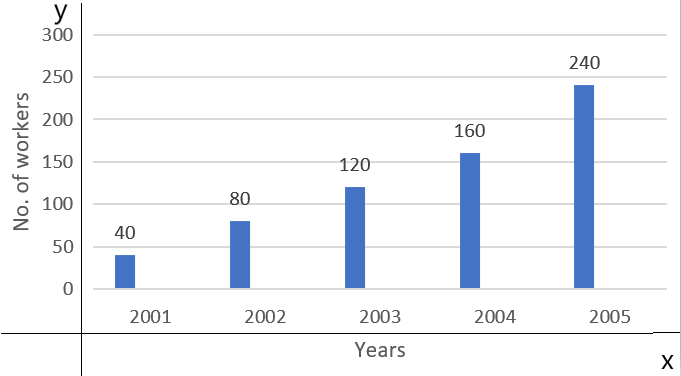
What is a simple bar diagram?
Construct a simple bar diagram from the following data
Year 2001 2002 2003 2004 2005 No. of workers. 40 80 120 160 240
| Year | 2001 | 2002 | 2003 | 2004 | 2005 |
| No. of workers. | 40 | 80 | 120 | 160 | 240 |
Answer
501.3k+ views
Hint: In this problem, we can see about a simple bar diagram and we can draw a bar diagram for the given data. We should know that a simple bar diagram is used to represent data involving only one variable classified on a spatial quantitative or temporal basis. In a simple bar chart, we make bars of equal width but vary in length, i.e. the magnitude of the quantity is represented by the height or length of the bars. We can also draw a bar diagram for the given data.
Complete step by step answer:
Here we can see a simple bar diagram.
We should know that a simple bar diagram is used to represent data involving only one variable classified on a spatial quantitative or temporal basis. In a simple bar chart, we make bars of equal width but vary in length, i.e. the magnitude of the quantity is represented by the height or length of the bars.
We can now draw a simple bar diagram for

Here we can see that, the x-axis has the number of workers and the y-axis has the year, where the number of workers increases gradually year by year.
Note: We should know that a simple bar diagram is used to represent data involving only one variable classified on a spatial quantitative or temporal basis. In a simple bar chart, we make bars of equal width but vary in length, i.e. the magnitude of the quantity is represented by the height or length of the bars.
Complete step by step answer:
Here we can see a simple bar diagram.
We should know that a simple bar diagram is used to represent data involving only one variable classified on a spatial quantitative or temporal basis. In a simple bar chart, we make bars of equal width but vary in length, i.e. the magnitude of the quantity is represented by the height or length of the bars.
We can now draw a simple bar diagram for
| Year | 2001 | 2002 | 2003 | 2004 | 2005 |
| No. of workers. | 40 | 80 | 120 | 160 | 240 |

Here we can see that, the x-axis has the number of workers and the y-axis has the year, where the number of workers increases gradually year by year.
Note: We should know that a simple bar diagram is used to represent data involving only one variable classified on a spatial quantitative or temporal basis. In a simple bar chart, we make bars of equal width but vary in length, i.e. the magnitude of the quantity is represented by the height or length of the bars.
Recently Updated Pages
Master Class 9 General Knowledge: Engaging Questions & Answers for Success

Master Class 9 English: Engaging Questions & Answers for Success

Master Class 9 Science: Engaging Questions & Answers for Success

Class 9 Question and Answer - Your Ultimate Solutions Guide

Master Class 12 Economics: Engaging Questions & Answers for Success

Master Class 12 Maths: Engaging Questions & Answers for Success

Trending doubts
Which places in India experience sunrise first and class 9 social science CBSE

Fill the blanks with the suitable prepositions 1 The class 9 english CBSE

Write the 6 fundamental rights of India and explain in detail

Difference Between Plant Cell and Animal Cell

What is pollution? How many types of pollution? Define it

What is the Full Form of ISI and RAW




